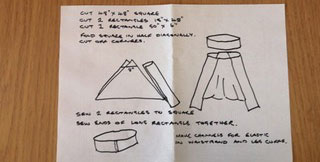African Culture Transformed: One-Yard Print Challenge
Carrie SchneiderRecently, San Diego Mesa College Fashion Program was involved with a collaboration with the African Art collection at the college and Visions Art Museum in Liberty Station, San Diego.
Students designed fabrics using imagery from the online African Art archives. Approximately 20 fabrics were printed in one-yard pieces. These fabrics were placed in an exhibit at the museum called African Art Transformed.
In early March, the museum hosted a fashion show of African-inspired garments from Mesa Fashion students (also part of the collaborative effort). Carrie was challenged to create a garment from a one-yard piece of fabric. And this she did, not once, but twice, with two fabrics she had designed.
Here are Carrie's prints.
And now... look at what Carrie managed to do with a single yard of each! She used Garment Designer to create the pattern and her ingenuity to manage garments with a yard of fabric.
 |
| Straight skirt |
 |
| Square neck, cap-sleeved top |
A little about Carrie
Carrie Schneider is a biologist who never fails to be entertained by the unique and fascinating qualities of San Diego's natural habitats. She grew up in the verdant countryside of the Hoosier state then moved to the east coast, where she earned a Ph.D from the Massachusetts Institute of Technology and is now a consultant in biotechnology company. She led the Environmental Systems subcommittee for the City Wide Canyons Sewer Maintenance Task Force, whose proposed improvements to City procedures for accessing sewer infrastructure in open space parks were adopted by the City Council in 2002. She is a co-founder of San Diego Canyonlands, started the Friends of Switzer Canyon in North Park, and continues to lead volunteers to restore upland and stream-side habitat. She enjoys contributing to the Herbarium collections at the San Diego Natural History Museum as a trained parabotanist for the Plant Atlas project and was president of the San Diego chapter of the California Native Plant Society from 2002-2004.






















